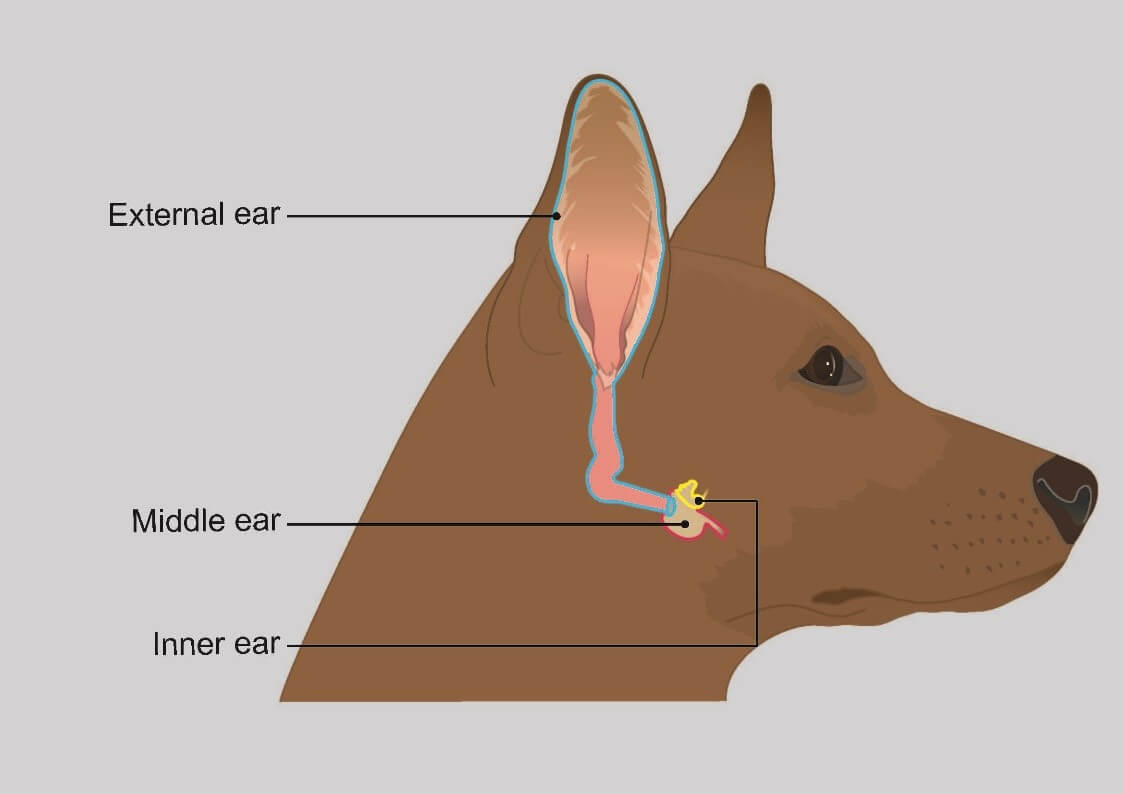Vestibular Syndrome in Dogs: Everything You Need to Do


Written and verified by the biologist Cesar Paul Gonzalez Gonzalez
Vestibular syndrome in dogs is a relatively frequent pathology that affects their sense of balance and proprioception. Although not all cases are serious enough to incapacitate the dog, it’s important to learn to detect it and to get to know its effects. In this way, you can avoid many unnecessary additional problems for your pet.
The vestibular system has several components that are distributed in the skull and spinal cord. When any of them is affected, it produces a specific condition known as vestibular syndrome. Continue reading this space and discover everything you need to know about this pathology in dogs.
The vestibular system of dogs

According to an article published in the journal Veterinary Clinics: Small Animal Practice, a dog’s vestibular system is divided into two parts:
- Peripheral vestibular system: Made up of the semicircular canals, otolithic organs, vestibular ganglia, and vestibulocochlear nerve, located in the inner ear.
- Central vestibular system: Constituted by the vestibular nuclei that have contact with the cerebellum, the spinal cord, and the cerebral cortex.
Although it seems complex, the mechanism of action of this system is relatively simple. In the first instance, the inner ear receives stimuli from its surroundings and sends the information via ganglia and nerves to the central vestibular system. The latter will process, analyze and send the appropriate commands for the body to maintain balance.
How can the inner ear detect the spatial position of the dog’s body?
Apart from the cochlea (which senses sound), the inner ear also has cavities filled with viscous fluid (endolymph) that are lined by sensitive hair cells.
When the position of the body changes, the fluid moves and stimulates the cilia of the cells. This is how the peripheral vestibular system obtains the spatial position of the body.
What is vestibular syndrome in dogs?
According to the veterinary website Davies Veterinary Specialists, the group of diseases that affect a dog’s balance system is called vestibular syndrome. Although each pathology has a different impact on the dog, they all produce a similar clinical picture. This is the reason why they’re known as vestibular syndrome.
Because the vestibular system also sends signals to the muscles and eyes, the problems generated by the syndrome can become disabling for your dog.
Of course, this depends on each case, but the general recommendation is to visit the veterinarian at the slightest warning sign.
How does this neurological disease appear in dogs?

When any part of the vestibular system is affected, different symptoms occur in the dog, all related to imbalance. These can vary in intensity depending on the pathology faced. Some of the most common clinical signs are the following:
- Loss of balance when walking
- Head tilting (permanent)
- Disorientation
- Involuntary eye movements (nystagmus)
- Difficulty getting up
- Vomiting or retching
- Refusal or reluctance to walk
- A circling gait
- Facial paralysis
Although the condition is similar in most cases, the reality is that there are some unique differences in each case. According to an article published in the Compendium on Continuing Education for Veterinarians, it’s thanks to this that it’s possible to distinguish whether the pathology affects the peripheral or central portion of the vestibular system. However, the diagnosis of your dog can only be made by your veterinarian.
Causes of vestibular syndrome in dogs
There are several pathologies or complications that are capable of altering or damaging part of the canine vestibular system. The website of The People’s Dispensary for Sick Animals lists some of the most frequent causes:
- Middle ear or inner ear infections (otitis)
- Age (geriatric dogs)
- Problems in the brain (tumors, infections or inflammation)
- Use of different medications (unwanted side effects)
- Idiopathic origin (no known cause)
The complete list of pathologies that cause this neurological disease in dogs is longer. In fact, an article published in The Veterinary Journal compiles the conditions or health problems that may affect the vestibular system:
- Congenital problems: associated with deafness
- Degenerative problems: cerebellar abiotrophy
- Neoplasms: squamous cell carcinoma, fibrosarcoma, meningioma, lymphoma and osteosarcoma, to mention a few
- Infections or inflammations: labyrinthitis, cryptococcosis and nasopharyngeal polyps
- Trauma: fractures or strong blows to the head or near the external ear
- Hormonal problems: hypothyroidism
- Vascular problems: cerebrovascular accidents
- Nutritional deficiencies: low thiamine levels
Before becoming alarmed, remember that many of these last causes aren’t so frequent or common. Therefore, try to visit a veterinarian as soon as possible, so that he/she can make the diagnosis and rule out the possibilities.
Diagnosis
To diagnose vestibular syndrome in dogs, professionals usually divide the process into several phases. First, a history, vital signs, and physical examination are chosen.
This is to understand the severity of the symptoms and their possible origin, so it’s normal at this point to carry out locomotion and sensitivity tests, as well as ear examinations.
If the veterinarian hasn’t been able to determine the possible origin of your pet’s condition, then he or she will likely order additional tests, such as X-rays, CT scans, and blood tests. However, keep in mind that this is at the discretion of the specialist, so they aren’t necessary in all cases.
Although the clinical picture of vestibular syndrome in dogs is easy to distinguish, it isn’t always possible to determine its origin. These scenarios are known as “idiopathic cases” and, according to a study published in BMC Veterinary Research, this is one of the most common causes of this neurological disease in dogs.
Geriatric dogs with vestibular syndrome

Older dogs have a certain susceptibility to idiopathic vestibular syndrome. This is why it’s also known as “geriatric dog vestibular syndrome.” According to a study published in the Journal of Small Animal Practice, the average age at which this problem appears is from the age of 10 years, although it varies a little according to the breed.
Of course, not all cases of geriatric dogs with vestibular syndrome are idiopathic; they may have another pathology that’s causes the symptoms. Because of this, a professional diagnosis should be made to rule out other pathologies. This is especially important, because at this age it’s common to have other problems in the body, such as metabolic diseases or neoplasms.
Available treatment
The treatment of this neurological disease in dogs is focused on eliminating or controlling the cause that causes the condition. In severe cases, the dog may need to be stabilized by supportive therapy before the main treatment is initiated. This includes the use of sedatives and antiemetics, to combat the symptoms produced by the syndrome.
As mentioned in an article published in The Veterinary Record, the veterinarian should approach the problem with various approaches, depending on the needs of the case. Some of the available options to treat vestibular syndrome in dogs are the following:
- Administration of antibiotics: to eliminate bacterial infections such as otitis
- Administration of corticosteroids: to control various types of inflammation
- Chemotherapies: in case of neoplasias
- Surgical intervention: in cases of trauma or neoplasms
- Change of diet: to solve nutritional deficiencies
- Administration of hormonal drugs: to control problems such as hypothyroidism
In the specific case of idiopathic vestibular syndrome, palliative supportive treatment (medications to alleviate symptoms) is usually chosen. Not knowing the origin of the problem, it’s impossible to correct it. However, many dogs with this condition recover spontaneously, after a few days or months.
Prognosis
The prognosis of vestibular syndrome in dogs is variable, as each case is unique and it isn’t possible to generalize the scenarios. Although it’s true that many dogs recover completely and don’t suffer sequelae, this only applies to the most common cases such as otitis and some idiopathic cases.
When nerve damage is severe or the cause of the syndrome can’t be eliminated, dogs retain several of the symptoms long term. These can be as simple as head tilting or as severe as the inability to walk.
As mentioned by the portal VCA Animal Hospitals, even if the dogs recover completely, it’s possible that some of them may suffer lifelong stumbling or staggering. It all depends on the case and the type of pathology the dog is suffering from.
Early attention
As you can see, vestibular syndrome in dogs is a problem that should be taken seriously and acted on promptly. If you observe any of the symptoms described above, the best thing to do is to visit a veterinarian as soon as possible. Keep in mind that, if the disease is detected early, there’s a better chance that your companion will recover completely.
Vestibular syndrome in dogs is a relatively frequent pathology that affects their sense of balance and proprioception. Although not all cases are serious enough to incapacitate the dog, it’s important to learn to detect it and to get to know its effects. In this way, you can avoid many unnecessary additional problems for your pet.
The vestibular system has several components that are distributed in the skull and spinal cord. When any of them is affected, it produces a specific condition known as vestibular syndrome. Continue reading this space and discover everything you need to know about this pathology in dogs.
The vestibular system of dogs

According to an article published in the journal Veterinary Clinics: Small Animal Practice, a dog’s vestibular system is divided into two parts:
- Peripheral vestibular system: Made up of the semicircular canals, otolithic organs, vestibular ganglia, and vestibulocochlear nerve, located in the inner ear.
- Central vestibular system: Constituted by the vestibular nuclei that have contact with the cerebellum, the spinal cord, and the cerebral cortex.
Although it seems complex, the mechanism of action of this system is relatively simple. In the first instance, the inner ear receives stimuli from its surroundings and sends the information via ganglia and nerves to the central vestibular system. The latter will process, analyze and send the appropriate commands for the body to maintain balance.
How can the inner ear detect the spatial position of the dog’s body?
Apart from the cochlea (which senses sound), the inner ear also has cavities filled with viscous fluid (endolymph) that are lined by sensitive hair cells.
When the position of the body changes, the fluid moves and stimulates the cilia of the cells. This is how the peripheral vestibular system obtains the spatial position of the body.
What is vestibular syndrome in dogs?
According to the veterinary website Davies Veterinary Specialists, the group of diseases that affect a dog’s balance system is called vestibular syndrome. Although each pathology has a different impact on the dog, they all produce a similar clinical picture. This is the reason why they’re known as vestibular syndrome.
Because the vestibular system also sends signals to the muscles and eyes, the problems generated by the syndrome can become disabling for your dog.
Of course, this depends on each case, but the general recommendation is to visit the veterinarian at the slightest warning sign.
How does this neurological disease appear in dogs?

When any part of the vestibular system is affected, different symptoms occur in the dog, all related to imbalance. These can vary in intensity depending on the pathology faced. Some of the most common clinical signs are the following:
- Loss of balance when walking
- Head tilting (permanent)
- Disorientation
- Involuntary eye movements (nystagmus)
- Difficulty getting up
- Vomiting or retching
- Refusal or reluctance to walk
- A circling gait
- Facial paralysis
Although the condition is similar in most cases, the reality is that there are some unique differences in each case. According to an article published in the Compendium on Continuing Education for Veterinarians, it’s thanks to this that it’s possible to distinguish whether the pathology affects the peripheral or central portion of the vestibular system. However, the diagnosis of your dog can only be made by your veterinarian.
Causes of vestibular syndrome in dogs
There are several pathologies or complications that are capable of altering or damaging part of the canine vestibular system. The website of The People’s Dispensary for Sick Animals lists some of the most frequent causes:
- Middle ear or inner ear infections (otitis)
- Age (geriatric dogs)
- Problems in the brain (tumors, infections or inflammation)
- Use of different medications (unwanted side effects)
- Idiopathic origin (no known cause)
The complete list of pathologies that cause this neurological disease in dogs is longer. In fact, an article published in The Veterinary Journal compiles the conditions or health problems that may affect the vestibular system:
- Congenital problems: associated with deafness
- Degenerative problems: cerebellar abiotrophy
- Neoplasms: squamous cell carcinoma, fibrosarcoma, meningioma, lymphoma and osteosarcoma, to mention a few
- Infections or inflammations: labyrinthitis, cryptococcosis and nasopharyngeal polyps
- Trauma: fractures or strong blows to the head or near the external ear
- Hormonal problems: hypothyroidism
- Vascular problems: cerebrovascular accidents
- Nutritional deficiencies: low thiamine levels
Before becoming alarmed, remember that many of these last causes aren’t so frequent or common. Therefore, try to visit a veterinarian as soon as possible, so that he/she can make the diagnosis and rule out the possibilities.
Diagnosis
To diagnose vestibular syndrome in dogs, professionals usually divide the process into several phases. First, a history, vital signs, and physical examination are chosen.
This is to understand the severity of the symptoms and their possible origin, so it’s normal at this point to carry out locomotion and sensitivity tests, as well as ear examinations.
If the veterinarian hasn’t been able to determine the possible origin of your pet’s condition, then he or she will likely order additional tests, such as X-rays, CT scans, and blood tests. However, keep in mind that this is at the discretion of the specialist, so they aren’t necessary in all cases.
Although the clinical picture of vestibular syndrome in dogs is easy to distinguish, it isn’t always possible to determine its origin. These scenarios are known as “idiopathic cases” and, according to a study published in BMC Veterinary Research, this is one of the most common causes of this neurological disease in dogs.
Geriatric dogs with vestibular syndrome

Older dogs have a certain susceptibility to idiopathic vestibular syndrome. This is why it’s also known as “geriatric dog vestibular syndrome.” According to a study published in the Journal of Small Animal Practice, the average age at which this problem appears is from the age of 10 years, although it varies a little according to the breed.
Of course, not all cases of geriatric dogs with vestibular syndrome are idiopathic; they may have another pathology that’s causes the symptoms. Because of this, a professional diagnosis should be made to rule out other pathologies. This is especially important, because at this age it’s common to have other problems in the body, such as metabolic diseases or neoplasms.
Available treatment
The treatment of this neurological disease in dogs is focused on eliminating or controlling the cause that causes the condition. In severe cases, the dog may need to be stabilized by supportive therapy before the main treatment is initiated. This includes the use of sedatives and antiemetics, to combat the symptoms produced by the syndrome.
As mentioned in an article published in The Veterinary Record, the veterinarian should approach the problem with various approaches, depending on the needs of the case. Some of the available options to treat vestibular syndrome in dogs are the following:
- Administration of antibiotics: to eliminate bacterial infections such as otitis
- Administration of corticosteroids: to control various types of inflammation
- Chemotherapies: in case of neoplasias
- Surgical intervention: in cases of trauma or neoplasms
- Change of diet: to solve nutritional deficiencies
- Administration of hormonal drugs: to control problems such as hypothyroidism
In the specific case of idiopathic vestibular syndrome, palliative supportive treatment (medications to alleviate symptoms) is usually chosen. Not knowing the origin of the problem, it’s impossible to correct it. However, many dogs with this condition recover spontaneously, after a few days or months.
Prognosis
The prognosis of vestibular syndrome in dogs is variable, as each case is unique and it isn’t possible to generalize the scenarios. Although it’s true that many dogs recover completely and don’t suffer sequelae, this only applies to the most common cases such as otitis and some idiopathic cases.
When nerve damage is severe or the cause of the syndrome can’t be eliminated, dogs retain several of the symptoms long term. These can be as simple as head tilting or as severe as the inability to walk.
As mentioned by the portal VCA Animal Hospitals, even if the dogs recover completely, it’s possible that some of them may suffer lifelong stumbling or staggering. It all depends on the case and the type of pathology the dog is suffering from.
Early attention
As you can see, vestibular syndrome in dogs is a problem that should be taken seriously and acted on promptly. If you observe any of the symptoms described above, the best thing to do is to visit a veterinarian as soon as possible. Keep in mind that, if the disease is detected early, there’s a better chance that your companion will recover completely.
All cited sources were thoroughly reviewed by our team to ensure their quality, reliability, currency, and validity. The bibliography of this article was considered reliable and of academic or scientific accuracy.
- Bongartz, U., Nessler, J., Maiolini, A., Stein, V. M., Tipold, A., & Bathen‐Nöthen, A. (2020). Vestibular disease in dogs: association between neurological examination, MRI lesion localisation and outcome. Journal of Small Animal Practice, 61(1), 57-63. https://pubmed.ncbi.nlm.nih.gov/31515806/
- Davies Veterinary Specialists. (s.f.). Vestibular Syndrome in Dogs and Cats Fact Sheet. Consultado el 26 de mayo de 2023. https://vetspecialists.co.uk/fact-sheets-post/vestibular-syndrome-in-dogs-and-cats-fact-sheet/#:~:text=Vestibular%20syndrome%20refers%20to%20a,known%20as%20the%20vestibular%20system).&text=Common%20signs%20of%20vestibular%20syndrome,the%20eyes%20and%20general%20wobbliness
- Garosi, L. (2007). Vestibular disease in dogs and cats. In Practice, 29(3), 151-157. https://bvajournals.onlinelibrary.wiley.com/doi/abs/10.1136/inpract.29.3.151
- Harrison, E., Grapes, N. J., Volk, H. A., & De Decker, S. (2021). Clinical reasoning in canine vestibular syndrome: Which presenting factors are important? Veterinary Record, 188(6), 1-10. https://www.researchgate.net/publication/349456112_Clinical_reasoning_in_canine_vestibular_syndrome_Which_presenting_factors_are_important
- Kent, M., Platt, S. R., & Schatzberg, S. J. (2010). The neurology of balance: function and dysfunction of the vestibular system in dogs and cats. The Veterinary Journal, 185(3), 247-258. https://pubmed.ncbi.nlm.nih.gov/19944632/
- Kraeling, M. (2014). Proposed treatment for geriatric vestibular disease in dogs. Topics in Companion Animal Medicine, 29(1), 6-9. https://pubmed.ncbi.nlm.nih.gov/25103883/
- Lowrie, M., & Vetmb, M. A. (2012). Vestibular disease: diseases causing vestibular signs. Compendium: Continuing Education for Veterinarians, 34(7), 1-6. https://europepmc.org/article/med/22847321
- Orlandi, R., Gutierrez-Quintana, R., Carletti, B., Cooper, C., Brocal, J., Silva, S., & Gonçalves, R. (2020). Clinical signs, MRI findings and outcome in dogs with peripheral vestibular disease: a retrospective study. BMC Veterinary Research, 16(1), 1-10. https://bmcvetres.biomedcentral.com/articles/10.1186/s12917-020-02366-8
- Rossmeisl, J. H. (2010). Vestibular disease in dogs and cats. Veterinary Clinics: Small Animal Practice, 40(1), 81-100. https://www.vetsmall.theclinics.com/article/S0195-5616(09)00145-4/fulltext
- The People’s Dispensary for Sick Animals. (s.f.). Vestibular Disease in dogs. Consultado el 26 de mayo de 2023. https://www.pdsa.org.uk/pet-help-and-advice/pet-health-hub/conditions/vestibular-disease-in-dogs
- Wier, M. & Ward, D. (s.f.). Vestibular Disease in Dogs. VCA Animal Hospitals. Consultado el 26 de mayo de 2023. https://vcahospitals.com/know-your-pet/vestibular-disease-in-dogs
This text is provided for informational purposes only and does not replace consultation with a professional. If in doubt, consult your specialist.








